
Egyptian-blue waves with white trill gently crashing against the coastline as wild green iguana scurry across the greenery. Colonial fortresses continue to safeguard the umbrella colors of the Spanish architecture, whose culture continues to thrive throughout the United States territory island. An archipelago that includes a large main island with a number of small ones including Vieques and Culebra, Puerto Rico is the air and cruise ship hub of the Caribbean.
I remember my short time spent in Puerto Rico. With my husband and son, and some family-friends, our cruise ship stopped in San Juan, a city of both old and new. Founded in 1521, its bay continues to be one of the best harbors within the West Indies.
My family and I opted to just explore San Juan on our own. We were limited with only 3-4 hours to spend in the morning, when everything was still just opening. I plan to return soon and stay on the island, so I explore more of the green and fertile land with mountains running east to west through the center of the main island of Puerto Rico.
For luxury adventure seekers, Puerto Rico’s coast has excellent beaches and fine harbors, great for surfing or enjoying a private day at sea; rivers that flow from the mountains to the sea fun for those looking to zipline over these waters or tube in them; and then there is the excitement of San Juan itself.


Puerto Rico is unique in that it has two official languages. With a strong cultural foundation in the Spanish heritage, almost all Puerto Ricans continue to maintain the Spanish language. Becoming a United States territory in 1917, English started becoming the growing language as it was being taught in schools.

While Puerto Rico once was a destination that accepted currency from all around the world, by Spanish colonization, the island was relying on the currency of Spain. By 1913, and continuing through today, Puerto Rico uses the United States dollar, though they may refer to it as ‘peso’ or ‘dollar.’

Luckily for us, those who are citizens or residents of the United States do not require a visa or passport to travel to this island, when traveling from the mainland.

As Puerto Rico is part of the United States, U.S. cell phone plans with roaming should work. Unfortunately, while part of the United States, Puerto Rico has been locked out of most federal funding available to U.S. states which hinders its ability to expand internet services. While WI-FI in many local places may be non-existent, many of the resorts on the island do offer plans.

Like the United States, you generally tip in Puerto Rico. Bars -tip $1 per drink. Luggage attendants - tip $1 to $2 per bag for anyone who helps with your luggage. Restaurants - tip 15% of the bill. Taxis - tip 15% of the fare. Always remember to check for service charges included in your bill at touristy restaurants, even for groups smaller than six. If possible, try to tip servers with cash even when paying by credit card; this precludes management from taking a partial cut.

ATMs dispensing US currency are easily found. Credit and debit cards are widely accepted but watch out for mandatory fees at upscale hotels and resorts.

ATMs dispensing US currency are easily found. Credit and debit cards are widely accepted but watch out for mandatory fees at upscale hotels and resorts.

The best time to visit Puerto Rico is from mid-April to June, right after the busy winter season and just before the rainy summer. Spring weather is also very pleasant, barely escaping the mid-80s on most days.
There are many options for getting around Puerto Rico. With numerous flights connecting various airports around the island, including Culebra and Vieques; a ferry service from San Juan to various nearby destinations, including from Fajardo to Vieques and Culebra; to the train, bus, taxis, and públicos, you won’t have any problem reaching your destination or going out and exploring all that Puerto Rico has to offer.
From the airport, look for the Taxi Turístico, which carries the signature Garita (sentry box) icon as their logo. You can also find them at designated taxi stands at various points in San Juan. Taxis can be expensive, with rates from the airport to Condado, Old San Juan, and Isla Verde starting at $15.
A público is a privately operated shuttle service that transports people all over the island. This is a great option if you've got time on your hands (a cross-island trip can easily run several hours long with multiple stops), want to see small, local towns along the way, and enjoy mingling with blue-collar locals.
Puerto Rico's public buses are referred to as guaguas. Tourists in San Juan will be most interested in two lines: the A5, which travels from Old San Juan to Isla Verde, and the B21, which runs between Old San Juan, Condado, and the Plaza Las Américas Mall in Hato Rey.
The quickest and most effective way to travel across the island or to Vieques and Culebra is via a small plane. Several charter services and local airlines operate from San Juan's international Luis Muñoz Marín Airport in Isla Verde or its smaller local Isla Grande Airport in Miramar. Among the airlines you'll find here are: Air Flamenco, Vieques Air Link, Cape Air
As you would expect, virtually every car rental company has a presence in Puerto Rico, along with several local companies. Most renters must meet the same age requirements for renting a car on the mainland, United States: minimum age ranging from age 21 to age 25 to rent with a valid driver's license. Daily rates can range from $8/day to $25/day.
Train travel between cities doesn't exist, but you can get around metropolitan San Juan through the Tren Urbano (Urban Train), which is primarily a commuter train connecting residential and commercial points in the capital. As such, the Tren Urbano doesn't reach Old San Juan.
Puerto Rico has decent and very cheap ferry service. From Old San Juan, you can catch a ferry to Cataño (which is the cheapest way to get to the Bacardi distillery) or to Hato Rey (the banking district and the site of Plaza Las Américas. Most locals who want to get to Vieques and Culebra take the ferry from Fajardo. It lasts about two hours and will get you there safely. However, it's packed on long weekends and popular holidays, and service can be spotty. You can also take a car on the ferry, but the ferry service for cars is much more infrequent and less reliable.
The vibrancy of Puerto Rican culture truly comes alive in its dishes, as a celebration of flavors invites visitors to indulge in. Some of the favorites include mofongo, tostones, pasteles, arroz con gandules, tembleque, and coquito.
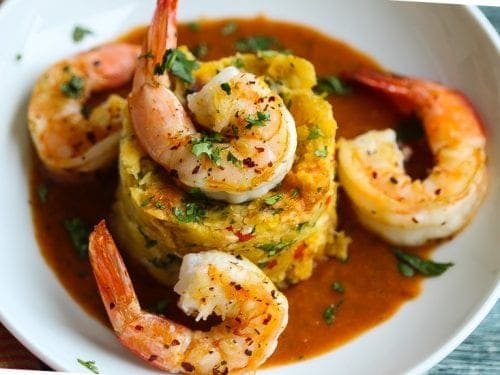
Mofongo is traditionally made from deep-fried green plantain pieces mashed with garlic and either salt-cured pork, pork crackling, butter, or oil. Some recipes use a salty broth to soften the plantains while mashing.

Tostones and amarillos are two traditional ways to prepare plantains. Tostones are made from green plantain, which is savory. The plantain is cut into thick wheels marinated in water and garlic, then deep-fried in oil to soften, smashed, and deep-fried again until crispy. Amarillos, on the other hand, are ripe plantains cut into pieces and fried until the outside is almost blackened, and the inside is soft and sweet.

Lechón Asado is a Puerto Rican culinary legacy! To prepare this delicacy, first, a whole pig (lechón) is marinated in adobo (a mix of garlic, oregano, black pepper, vinegar, and water) and then slowly roasted over coals for several hours until the meat is juicy and the skin crispy.
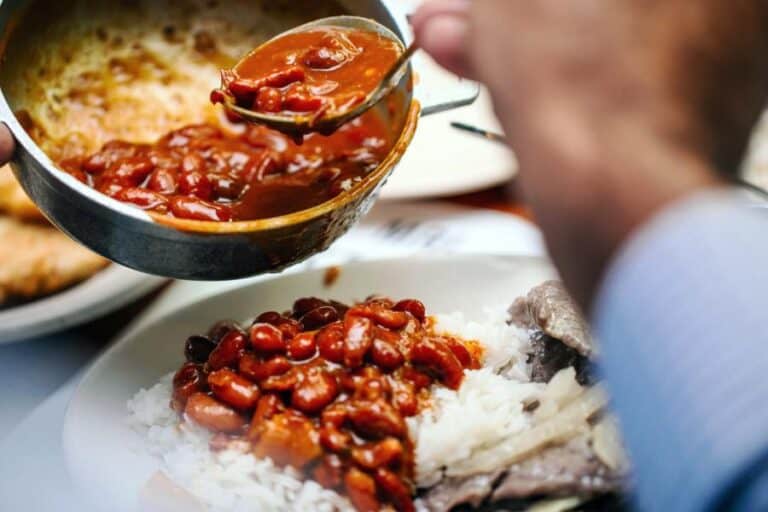
Arroz y habichuelas (rice and beans) are the quintessential Puerto Rican side dish. Pink beans are stewed with onions, peppers, garlic, ham hock, calabaza squash, and sofrito — a cooking base made by blending onion, garlic, peppers, culantro, cilantro, and oregano (as well as other herbs, spices, and aromatics depending on the family recipe).

A true local specialty, pasteles resemble tamales and are traditionally made with green banana masa stuffed with stewed pork meat. Sometimes yuca or other root vegetables are added; the masa can also be made with just yuca. Pasteles can also be stuffed with chicken or bacalao (salted cod), and some vegan versions have been introduced recently.

Considered a boricua staple, Arroz con gandules, a signature Puerto Rican rice dish, is consumed year-round. Pigeon peas, or gandules, are small, dense legumes cooked with the rice in a large pot.
Deciding where to stay during a vacation is nearly as important as choosing the destination itself. Luckily for you, no matter your style of traveling, Puerto Rico hotels and accommodations offer options to fit your budget and your preferences. You can choose a parador (small hotel) located in a nature reserve, or maybe you prefer a luxurious resort with exclusive service. Consider a glamping eco-retreat nestled in a bird sanctuary, or maybe stay in a vacation rental near the beach or in the mountains. Interested in history and culture? Stay in a historic hotel in Old San Juan, surrounded by restaurants, local shops, and bars.


El Yunque is the only tropical rainforest in the U.S. National Forest Service, and its name is a reference to Yuke, what the indigenous Taíno people defined as “white lands.” With an average rainfall of 120 inches a year, El Yunque has a very diverse ecosystem, hosting hundreds of unique plant and animal species, including the Island’s famous coquí frog.

If you’re seeking an eco-friendly, surreal experience, you should include a bioluminescent bay (Bahía) in Puerto Rico when planning your trip. These rare ecosystems happen when microscopic, single-celled organisms called dinoflagellates grow in quantities big enough to produce a “glow-in-the-dark” effect when stimulated by movement. So, when you paddle or splash the water, these organisms light up in a neon blue-green color, and so does everything they come in contact with, giving a star-like reflection to the water.

Cueva Ventana is a large cave situated atop a limestone cliff in Arecibo, Puerto Rico, overlooking the Río Grande de Arecibo valley. It is visible from the PR-123 but is accessible from a trail that begins adjacent to a Puma gas station located along PR-10 on kilometer 75.

Easily reached on a day trip east of the city, El Yunque, the anvil, is a mountain with the only tropical rain forest in the United States national forest system. Nearby, Luquillo Beach curves invitingly with white sand and fringing palms.
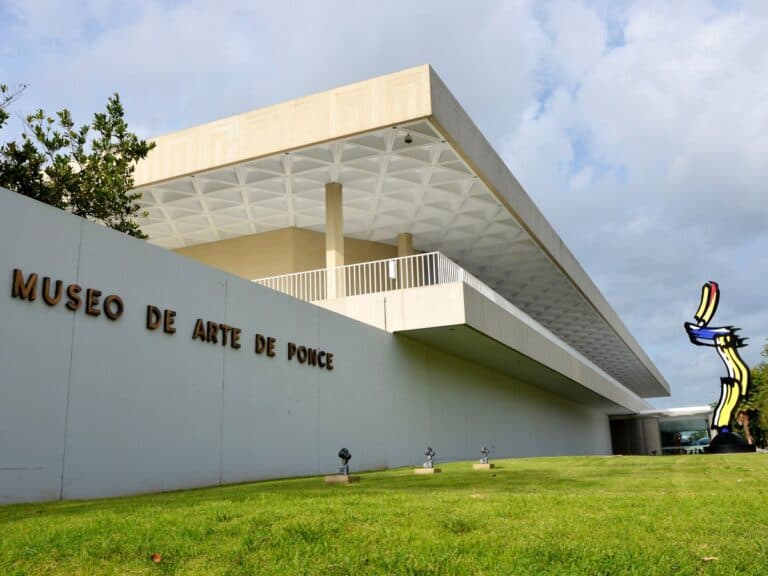
Ponce, about an hour and a half by toll road from San Juan, is the island’s second-largest city. Its museum has the Caribbean’s most extensive art collection including paintings, sculptures, prints, photographs, drawings, decorative arts, pre-Hispanic and African objects, Puerto Rican folk art, contemporary ceramics, video, and sound art.
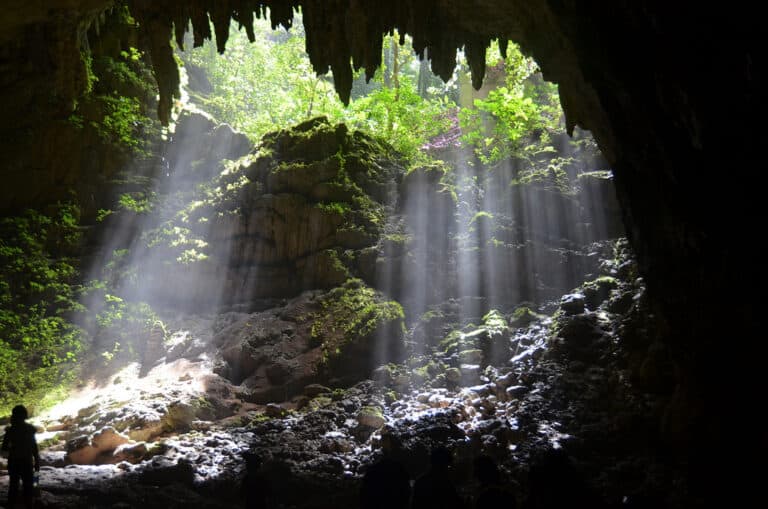
On the north coast, west of San Juan, Rio Camuy Cave Park is one of the world’s largest cave systems. It has a network of caves, sinkholes, and cathedral-sized caverns, as well as one of the world’s largest underground rivers. Petroglyphs etched into the walls by the Taino people provides evidence of the cave’s pre-Columbian occupation.
Accommodation
Hotel or Hostel (single): $48
Double-occupancy room: $97
Food
Meals for one day: $12
Transportation
Taxis, local buses, train: $4.91
Intercity: $20
Entertainment
Entrance tickets, shows: $16
Horseback riding tour: $40
1 hr Windsurfing lesson: $75
Full day snorkeling trip: $100
Alcohol
Drinks for one day: $4.65
Water
Bottled water for one day: $5.02
Accommodation
Hotel or rental home (single): $115
Double-occupancy room: $230
Food
Meals for one day: $28
Transportation
Taxis or Car rental: $12
Intercity: $48
Entertainment
Entrance tickets, shows: $39
Horseback riding tour: $40
1 hr Windsurfing lesson: $75
Full day snorkeling trip: $100
Alcohol
Drinks for one day: $11
Water
Bottled water for one day: $5.18
Accommodation
Resort or hotel (single): $245
Double-occupancy room: $490
Food
Meals for one day: $57
Transportation
Car Rentals or private driver: $25
Intercity: $103
Entertainment
Entrance tickets, shows: $89
Horseback riding tour: $40
1 hr Windsurfing lesson: $75
Full day snorkeling trip: $100
Alcohol
Drinks for one day: $21
Water
Bottled water for one day: $5.49
When planning for your trip to Puerto Rico, don’t forget about travel insurance! You never know what might happen and it’s better to be safe than sorry.

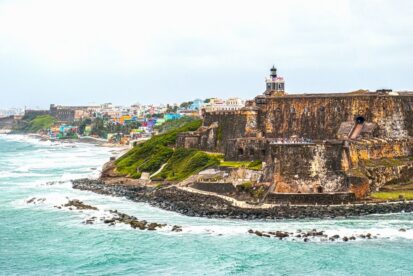


Interested in traveling the world while getting paid? Here at Diversifying Globetrotters LLC, we are partnered with Melanin On The Map and Travel Coach Network to help people across the world find financial, personal, and time freedom. Join the hundreds of others making the change to better themselves while exploring the world and adding money to their pockets.